At first sight, it may seem that to garden in the city goes against the grain of urban life. After the fall of socialism, especially in the big cities like Prague and Brno, there appeared voices calling for cancelling allotments on the grounds that allotment gardens represent a foreign element in the cities implanted there in socialism. The idea that allotments and garden colonies are an invention of socialism and do not belong to the city is incorrect and ignores the long history of urban gardening in allotments and the role gardens in colonies played and continue to play in the cities not only in the Czech Republic, but throughout whole Europe. On this page, you can find a brief overview of history and the present state of allotments in the Czech Republic as well as information about how allotments are approached abroad, where we can somewhere find more of them than in Czechia.
Allotments in the Czech Republic
In the Czech lands, allotments started to appear at the turn of the 19th and 20th century. It happened primarily in cities with prevalence of German speaking population such as Most (Brüx), Aš (Asch), Cheb (Eger). This was due to the fact that gardening in such a form was becoming popular throughout Germany where since the middle of the 19th century allotments (so called Schrebergärten) had been founded as a part of a “Schreberverein” gardening movement. These allotments, in Czech called Schreber’s (Šreber’s) gardens, looked like we know them from the present. They appeared in reaction to rapid development of cities (urbanization) and industry (industrialization), societal changes as well as changes to the environment, lack of food in times of crises, but also as a means of education of children and recreation of the inhabitants of cities.
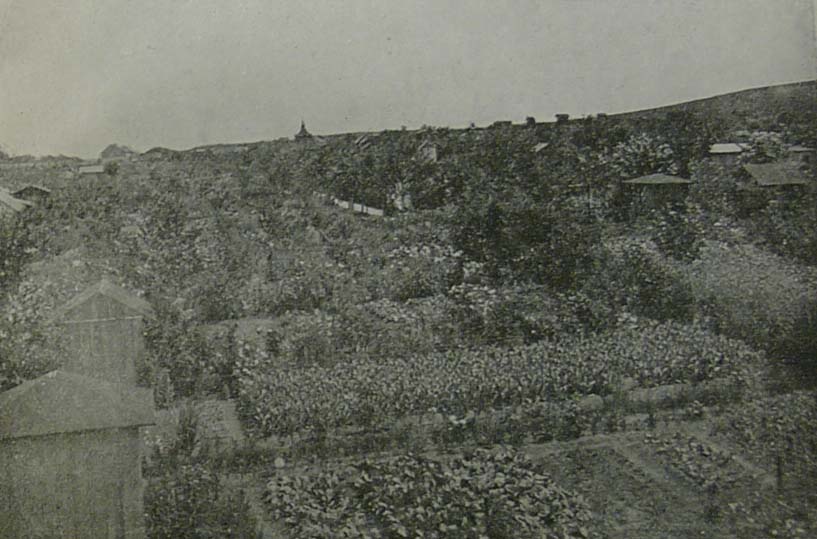 “A view of a part of a garden colony of the Society of family gardens in Žižkov” in Prague, a photograph from a book Garden colonies abroad and here by J. Pletánek, published by the Central association of societies for establishing and sustaining garden colonies in Czechoslovakia, page 33.
“A view of a part of a garden colony of the Society of family gardens in Žižkov” in Prague, a photograph from a book Garden colonies abroad and here by J. Pletánek, published by the Central association of societies for establishing and sustaining garden colonies in Czechoslovakia, page 33.
First allotments appeared in Prague in the 1890s in the form of worker’s garden colonies (e.g. at the Ringhoffer factory). In Brno, first Šreber’s gardens are documented by 1907. Allotment gardening boomed during both World Wars, when especially during the First World War gardens appeared often spontaneously because of shortages of food.
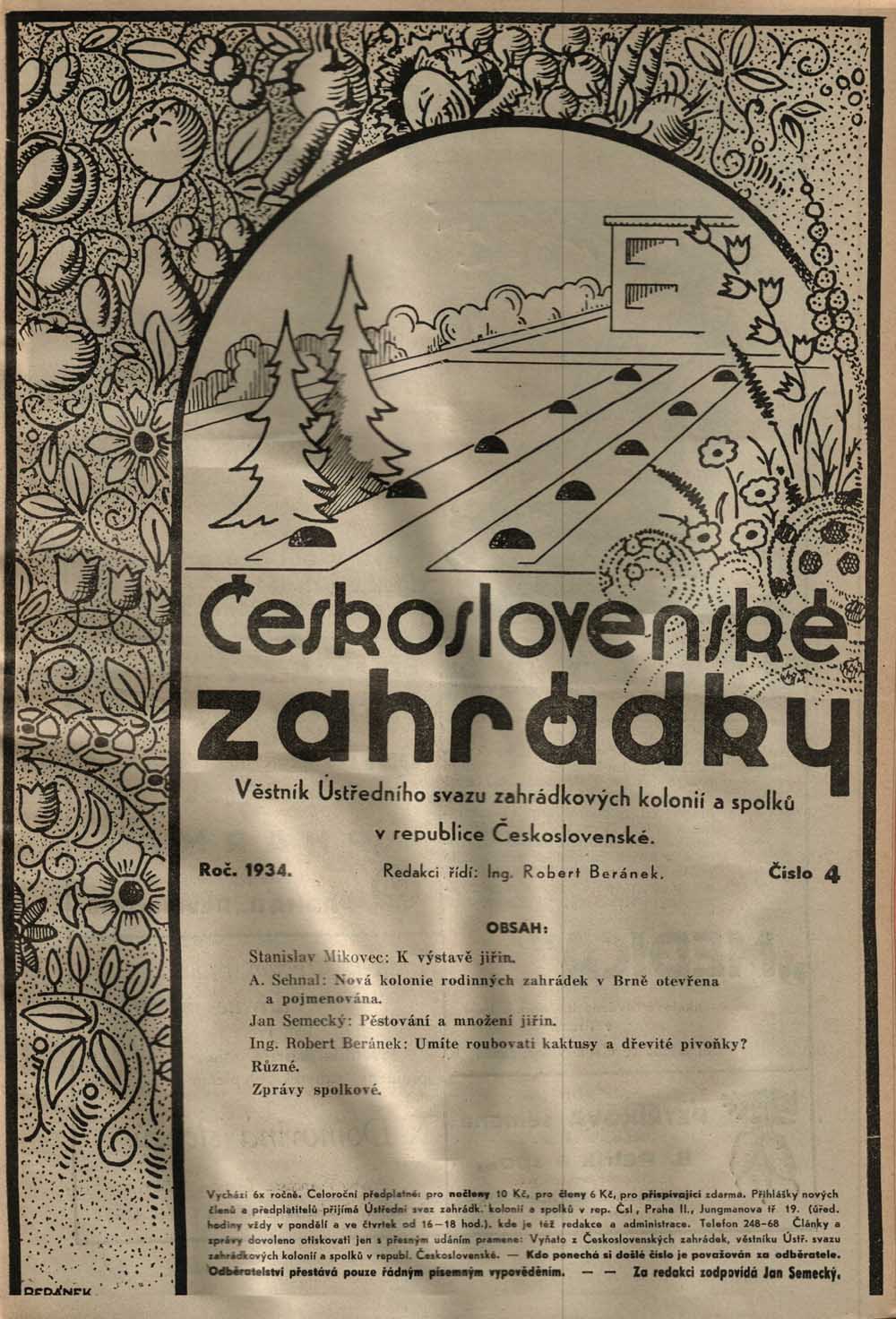 Cover of Czechoslovakian gardens, a gazette of the Central association of garden colonies and societies in the republic of Czechoslovakia from 1934In the interwar period, Czech gardening movement formed in the form of the Association of Czech societies for establishing and sustaining family and workers’ gardens and breeding of small animals which in time evolved in the current Czech gardening association. Oldest still existing Prague allotments, like allotments at the Libeň island (est. 1925) or at Ořechovka (est. 1928), originated at this time.
Cover of Czechoslovakian gardens, a gazette of the Central association of garden colonies and societies in the republic of Czechoslovakia from 1934In the interwar period, Czech gardening movement formed in the form of the Association of Czech societies for establishing and sustaining family and workers’ gardens and breeding of small animals which in time evolved in the current Czech gardening association. Oldest still existing Prague allotments, like allotments at the Libeň island (est. 1925) or at Ořechovka (est. 1928), originated at this time.
After the Second World War, the development of allotment gardening continued, but it collided with intense housing construction and a change of urban planning in Prague in the 1950s and 1960s. At the time, attempts at displacing the allotments from inside the city and especially on visually exposed hillsides appeared together with creating substitute allotments in the green belt around the city. Prague urban planners proposed places for new allotments and put forth rules for the development of garden colonies to where gardeners from cancelled ones should have relocated. In the times of normalization (in between 1969 and 1989), the number of garden colonies rose significantly with the most recent allotments founded during the 1980s.
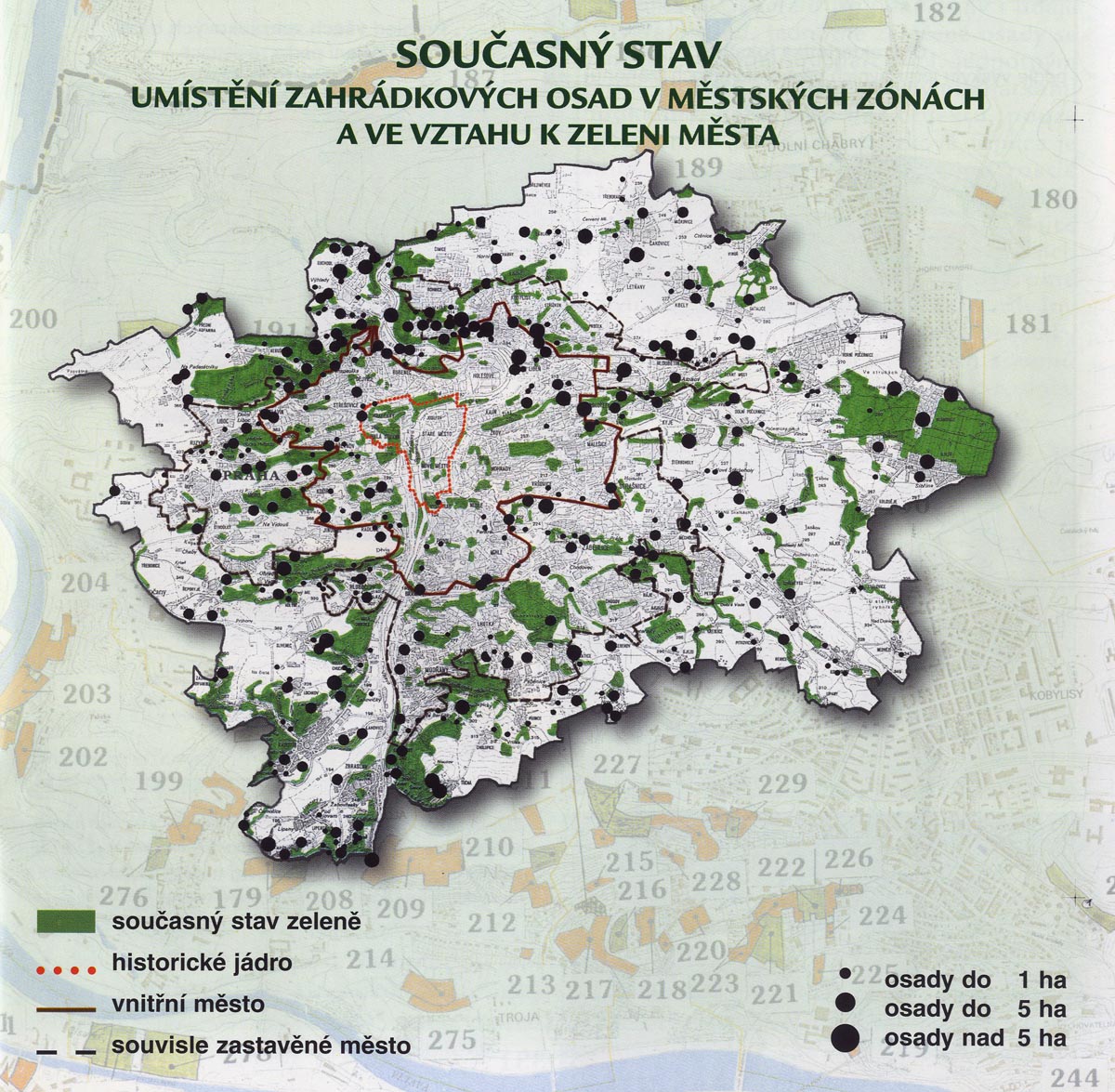 Distribution of allotments (garden colonies) in Prague in 1996, a map from the information brochure published by the Institute of Planning in Development in Prague in 1996 at the occasion of the preparation of the Plan for Prague allotments.
Distribution of allotments (garden colonies) in Prague in 1996, a map from the information brochure published by the Institute of Planning in Development in Prague in 1996 at the occasion of the preparation of the Plan for Prague allotments.
After the fall of socialism in 1989, the trend changed and since then allotments have been facing a pressure related to intense construction as well as incorrect view of allotments as remnants of the normalization times. The flood in 2002 led to the destruction of allotments in the vicinity of the river in the city centre (at the Císařský ostrov island) as well as beyond city borders. After the fall of interest in urban gardening and the recent change in public (and especially media) perception of allotments, the situation has been changing and the interest in gardening has been rising, not only among young families with children. New forms of urban gardening have emerged such as community gardening, guerrilla gardening as well as community farming in the Prague surroundings. New allotments have not been created and the future of those still in existence is often unsure. Despite the fact, we can find more than 300 garden colonies scattered around Prague with the exception of the historical city centre.
Allotments abroad
Urban gardening has a more than 150 year tradition in Europe. Its original development was related to the upswing of industrial society and the impact of industry to city and city life. In the 19th century, allotments and garden colonies appeared in big European industrial cities, namely in France, England, and Germany, and with the growth of cities and the boom of industry spread to whole Europe.
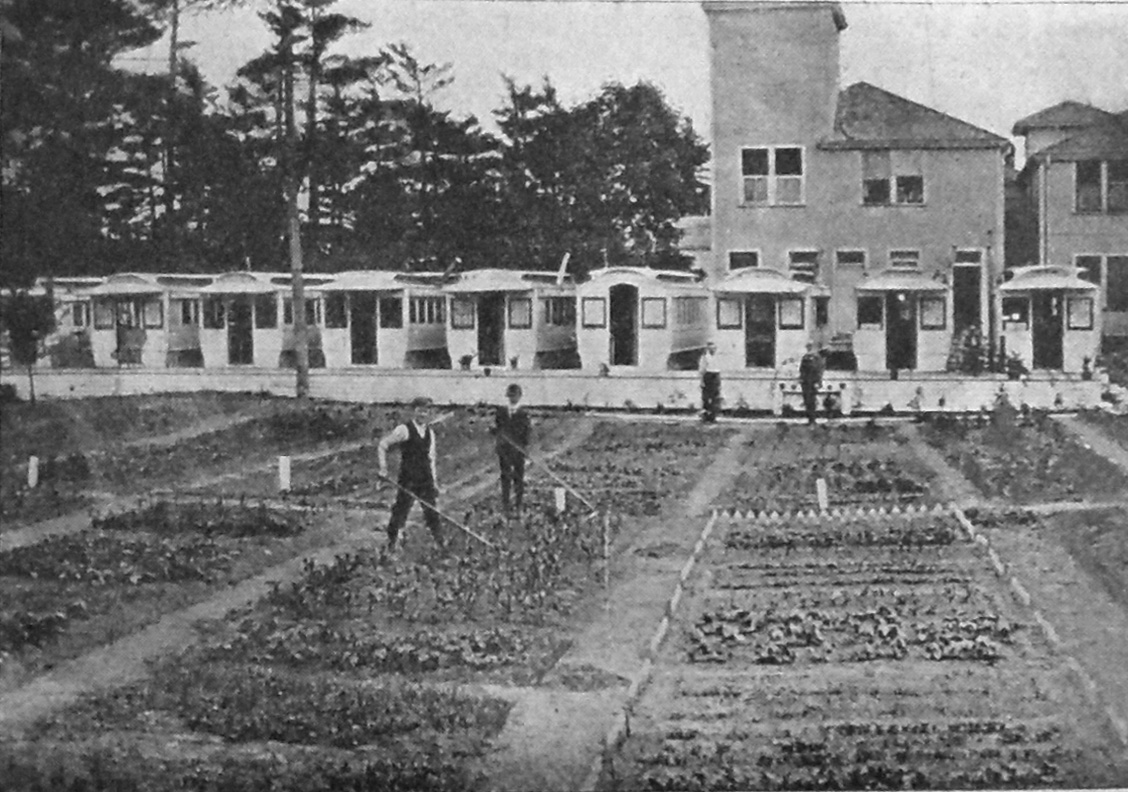 Gardens at the "colony of consumptives"” in Westen, England, 1912. The inscription below the photograph, published in Our garden: journal devoted to cultivating gardens at villas, family houses, flowers at households, windows, balconies, issue 1, 1912-1913, reads: "This image is interesting because it shows, how simple it is with little capital to found favourable colonies for convalescents. See the old tramway and omnibus carriages converted into bedrooms (each for two young gentlemen, members of London association of commerce). Everyone is required to grow plants on a lot designated for him so as he spends half a day at light work." Since the beginning, allotments served at least two purposes and it is thus possible to discern two roots of urban gardening. In Germany, allotments emphasised health and recreational function of gardening. In 1865, first gardens appeared in Leipzig named after Moritz Schreber, Leipzig physician and propagator of gardens as remedial tools. German gardening movement developed rapidly and became a key inspirational source for gardening movement in the Czech lands. In France, allotment gardens started to appear for social reasons when charities (such as Société de Saint-Vincent de Paul) provided urban poor with gardens to help with subsistence. Thus for example, as a means to provide and diversified the food for urban poor and workers, a French Union of Gardeners was founded in 1896 in Lyon.
Gardens at the "colony of consumptives"” in Westen, England, 1912. The inscription below the photograph, published in Our garden: journal devoted to cultivating gardens at villas, family houses, flowers at households, windows, balconies, issue 1, 1912-1913, reads: "This image is interesting because it shows, how simple it is with little capital to found favourable colonies for convalescents. See the old tramway and omnibus carriages converted into bedrooms (each for two young gentlemen, members of London association of commerce). Everyone is required to grow plants on a lot designated for him so as he spends half a day at light work." Since the beginning, allotments served at least two purposes and it is thus possible to discern two roots of urban gardening. In Germany, allotments emphasised health and recreational function of gardening. In 1865, first gardens appeared in Leipzig named after Moritz Schreber, Leipzig physician and propagator of gardens as remedial tools. German gardening movement developed rapidly and became a key inspirational source for gardening movement in the Czech lands. In France, allotment gardens started to appear for social reasons when charities (such as Société de Saint-Vincent de Paul) provided urban poor with gardens to help with subsistence. Thus for example, as a means to provide and diversified the food for urban poor and workers, a French Union of Gardeners was founded in 1896 in Lyon.
Popular, family or workers’ gardens soon spread to all European metropolises and other bigger cities, at first in western and central and later to northern as well as southern Europe. Since the establishment of gardening movement in the 19th century, gardening, its role and form in European societies underwent significant developments. Similarly to Czechia, gardening boomed during both world wars. In the first half of the 20th century, national gardening associations were established across the continent and in 1926 the European league of gardeners (The Office International du Coin de Terre et des Jardins Familiaux) was established. For economic reasons, the peak of gardening came during the Second World War – only in Berlin we could find more than 200,000 gardens and 1,750,000 allotment gardens in the Great Britain. In the 1950s and 1960s, similarly to Prague, allotments faced pressures of the intense housing construction. With the economic developments, the economic function of allotments (subsistence) receded especially in western and northern Europe with the social and recreational role having taken over. Similar developments coupled with the lack of possibilities of spending spare time and specific economic problems helped spreading allotments also in eastern, socialist part of Europe.
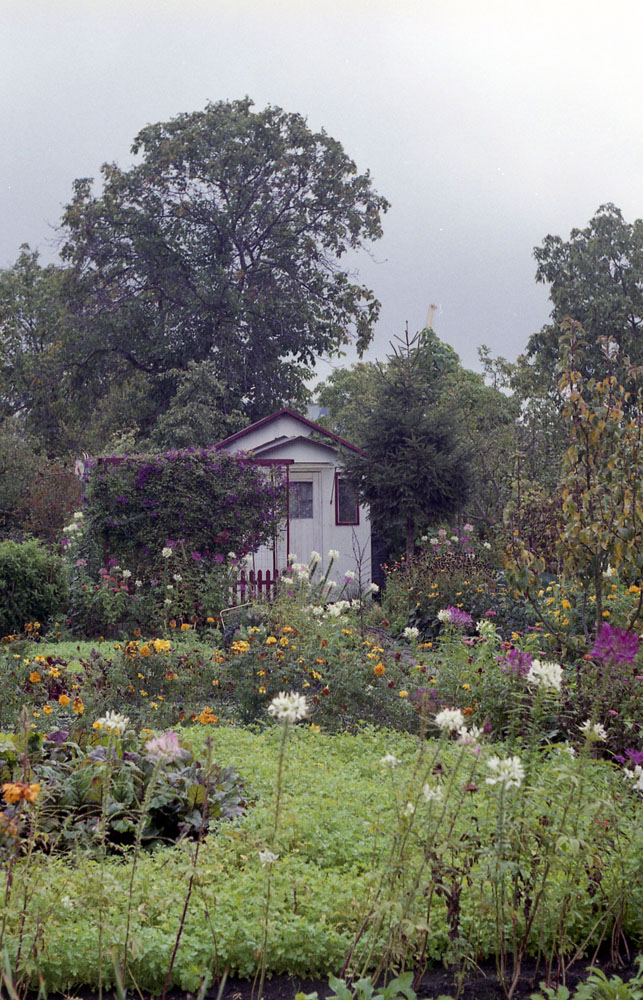 A view in a garden colony on the island in the middle of Oder in Sczeczin, Poland. Photographed in 2012 by Petr Gibas.Today, we find allotments in number of big cities in western and northern Europe as well as in the former eastern bloc. By the end of the 20th century, a general revaluation in the perception of allotments happened, which many of them saved from having been built over. Allotments are no longer seen as social, health and economic project for poorest classes of urbanites. They rather became spaces enabling the inhabitants of cities to spend their free time in an ecological way, produce local food, but also form a deep connection to a particular space in the city and thus also to a city as such based on active engagement. Moreover, allotments provide space for establishing social contacts among otherwise isolated individuals and groups, which in turn may help to sustain social cohesion and battle social exclusion. For this reason, so called social gardens are created in France, and in Germany and Sweden allotments are considered a tool for helping with integration of immigrants to society.
A view in a garden colony on the island in the middle of Oder in Sczeczin, Poland. Photographed in 2012 by Petr Gibas.Today, we find allotments in number of big cities in western and northern Europe as well as in the former eastern bloc. By the end of the 20th century, a general revaluation in the perception of allotments happened, which many of them saved from having been built over. Allotments are no longer seen as social, health and economic project for poorest classes of urbanites. They rather became spaces enabling the inhabitants of cities to spend their free time in an ecological way, produce local food, but also form a deep connection to a particular space in the city and thus also to a city as such based on active engagement. Moreover, allotments provide space for establishing social contacts among otherwise isolated individuals and groups, which in turn may help to sustain social cohesion and battle social exclusion. For this reason, so called social gardens are created in France, and in Germany and Sweden allotments are considered a tool for helping with integration of immigrants to society.
Urban garden colonies (allotments) have formed part of European cities since the half of the 19th century. They have a history of more than 150 years. They represent a manifestation of vast changes of modernity, a consequence of the development of cities and industry. Being highly local, sustainable and considered ecological together with social impacts represent the reason why urban gardening, often disdained and marginalised, has again become to develop and evolve throughout Europe with similar form of urban activities (such as urban farming) to be found across the Atlantic.
For more detailed account of the history of urban gardening in the Czech Republic and in Europe, see a chapter by Veronika Tvardková and Eliška Rolfováfrom the book Prague allotments: Shadows of the past, or glimpse of the future? (in Czech)